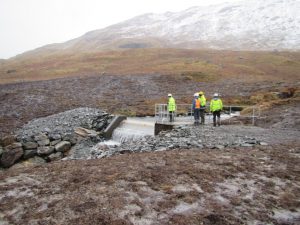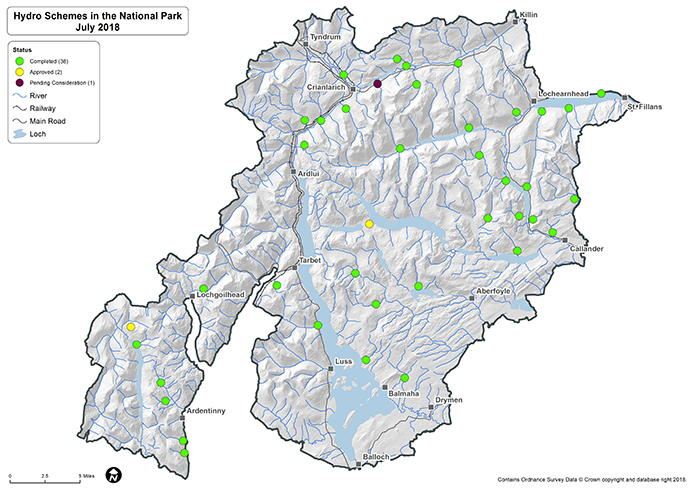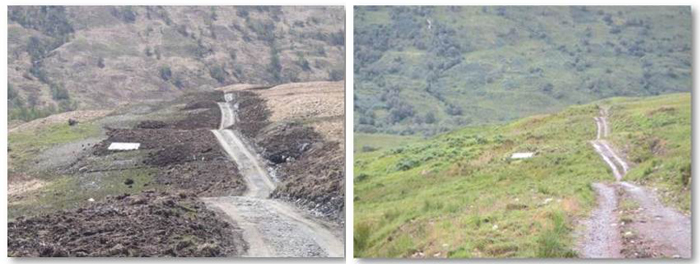
Run-of-river hydro schemes in the National Park
In the West of Scotland and we do get a lot of rain, which is why we support the development of ‘run-of-river’ hydro schemes in the National Park. And for them, lots of rain means more electricity production (and more income).
So, just what are run-of-river hydro schemes?
Run-of-river hydro schemes are not big dams with reservoirs behind them, such as that at Loch Sloy. They are smaller scale schemes. They take some (not all) of the water out of a burn at the ‘intake’ point, which is then carried down the hillside in a buried pipeline to a turbine house, before it is returned to the same burn at the ‘outfall’.
Why are they important in the National Park?
The National Parks (Scotland) Act 2000 sets our four aims and one of these is two to promote the sustainable use of the natural resources of the area. We also support the Scottish Government target of up to 100% of electricity and 11% of all heat in Scotland being generated through renewable energy sources by 2020.
The National Park, with its sensitive landscape is not the best place to build large scale wind or solar farms. However, it is an area with a lot of hills and rivers, and very high rainfall – which is great for run-of-river hydro schemes. They also have less visual impact, as pipelines are buried.
Where are there run-of-river hydro schemes in the National Park?
Just now there are 38 operational run-of-river hydro schemes in the National Park and four community hydro schemes. Our Planning Monitoring Officer keeps an eye on how all schemes get constructed, to ensure that the environment is protected. For most schemes recently constructed the monitoring will be ongoing up to 2020 and beyond this for the larger schemes. The monitoring is now focused on landscape restoration.
How we monitor the development of new schemes
We get monthly reports from developers keeping us up to date on progress with construction. We also go out on site, sometimes with colleagues from SEPA and colleagues from the Park’s Landscape and Ecology team to check things like: no sediment (mud) is entering the burn; that the turfs lifted to dig the pipeline corridor are stored separately to the deeper material, and that these are put back in the correct order so that the ground is restored as quickly as possible and a big grey ‘scar’ isn’t left on the hillside.
We have also required developers to employ Landscape and Ecology “Clerk of Works” (LCoWs and ECoWs). These are people with specialist skills (Landscape Architects and Ecologists) who work with contractors on-site to ensure that construction takes place according to best practice. For example reminding workers to avoid protected animals and to carefully route any roads in a way to ensure they are integrated within the landscape.
Before and after restoration of the track at Glen Falloch
Snagging
After construction most schemes have some landscaping work to do, including tree planting where necessary. We go out on site again to do a ‘snagging’ visit. At this visit we will point out things that might be missed (e.g. air vents painted in bright colours instead of dark green or grey which are less noticeable).
What’s coming next?
Due to changes in the funding mechanism for run-of-river schemes (Feed-in-Tariffs) we’ve seen a great reduction in the number of enquiries and applications for planning permission for these schemes. It seems likely that the type of schemes being implemented in the future will be even smaller scale – micro run-of-river, for farms to supply their own businesses rather than export to the National Grid.

How do I find out more?
We are currently developing a resource for schools, for pupils doing National 4/5 and Higher, which will be available on the National Park website when the 2016/17 term starts. Our ‘Renewable Energy’ Supplementary Planning Guidance sets out the Park’s guidance for hydro and other types of renewables suitable in the park. Finally, you can always look up ‘hydro’ on our e-planning portal to see past, current and applied for developments in the National Park.



